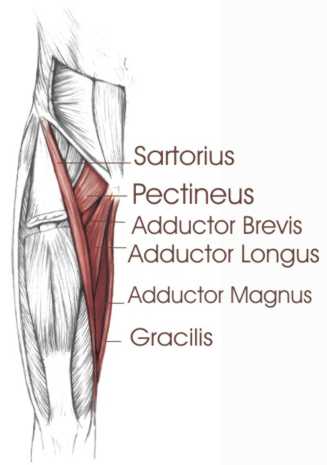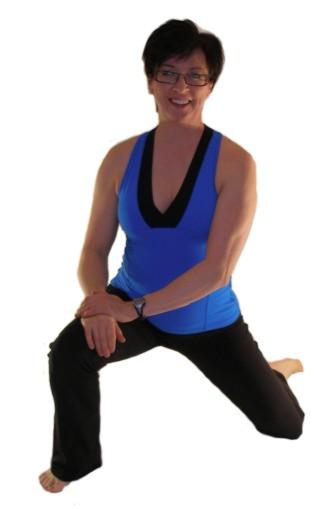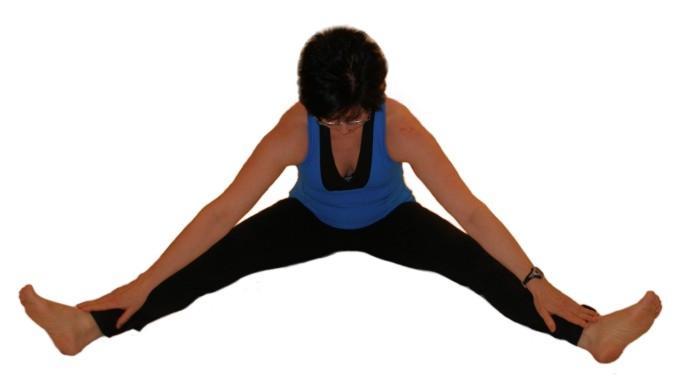Hip Stretches
It is common to develop muscle imbalances around the hip. Hip
stretches are part of a treatment plan to address these. In people that
sit at work for long periods of time hip flexors and rotators can
become tight, and gluteal muscles become weak. This can affect gait,
posture, spinal stability, and movement patterns.
Approximately 15 degrees of hip extension is required to walk normally.
If hip flexors are tight then in order to walk, compensatory movement
needs to take place through the lower back causing back pain and
premature disc degeneration. Like other joints, if we fail to take them
through their full range on a regular basis we eventually lose mobility.
Contents
What are the Major Muscles
of the Hip?
Why
do We do Hip Stretches?
What
is Piriformis
Syndrome?
The
Significance of Tight Hip Flexors in the Elderly
Hip
Stretches
Muscles of the Hip
Because the line of muscle action varies relative to the axis of rotation of the joint some muscles will have more than one action depending on the position of the hip.
Hip
Flexors
- Psoas Major and Minor
- Iliacus

Hip
Extensors
- Semimembranosus
- Semitendinosus
- Bicep Femoris
- Gluteus Maximus

Hip
Adductors
- Adductor Brevis
- Adductor Longus
- Adductor Magnus
- Pectineus
- Gracilis

Hip
Abductors
- Gluteus Medius
- Gluteus Minimus
- Tensor Fascia Lata
Hip
Rotators
- Piriformis
- Obturator Internus and Externus
- Superior and Inferior Gemelli
- Quadatratus Femoris

Why do We do Hip Stretches?
The hip is a very stable ball and socket type joint with an inherently
large range of motion. The hip contains some of the largest muscle in
the body as well as some of the smallest. Most people lack mobility due
to a relatively sedentary lifestyle. Periods of prolonged sitting
results in tightness of the hip flexors and hamstrings. Tightness in
the muscles and ligaments can created joint forces that result in
arthritis, postural problems,
bursitis, and mechanical back pain.
Positioning
of the hip affects pelvic and spinal posture and function so the
regular performance of hip stretches will help you maintain a good
posture and alignment.
What is Piriformis Syndrome?
The piriformis originates over the anterolateral surface of
the
sacrum where it lies close the the sacral nerves S2-S4. It then inserts
into the greater trochanter along with the other powerful external hip
rotators.
The syndrome consists of the symptoms that result from mechanical
impingement or irritation of the sciatic nerve as it emerges from the
pelvis. This can be pain, tingling, burning, or numbness that worsens
with movement of the hip into adduction, internal rotation, and
flexion.
Physical therapy is used to treat piriformis syndrome through
freeing up the nerve, increasing mobility, relaxing muscle
tone,
and increasing the resting length of the piriformis muscle. Hip stretches are one part of a treatment plan.
If you experience some of these symptoms you should consult a physical
therapist to rule out other sources of radiating leg pain.
The Significance of Tight Hip Flexors in the Elderly
Gait analysis studies in the elderly show that they typically have a
shortened step length. Whether that is a result of tight hip flexors or
due to reduced balance, the propensity to walk with shorter steps will
itself lead to tightness in hip flexors and anterior joint structures.
Hip stretches may be a relatively
easy preventative strategy for the elderly with gait abnormalities and
may help to prevent falls.
The only activity performed on a regular basis that fully extends the
hip is walking and running. Hence as activity levels decrease so does
the ability to extend the hip. This results in compensatory pelvic
tilting and lumbar extension, with a reduction in the ability to
accommodate uneven ground, negotiate obstacles, or attempt to change
walking speed quickly. The compensatory pelvic tilt that accompanies
tight hip flexors also predisposes the individual to postural
problems and back pain. Hip stretches done on a regular basis can help
you maintain extension range of motion and thereby improve function.
Hip Stretches
Hip Flexor Stretch
The hip flexors are the psoas major, psoas minor, and iliacus muscles,
all of which insert into the lesser trochanter on the femur.
- To stretch the left hip flexors kneel on your left knee and put your right foot in front of you such that your right hip and knee are about 90 degrees.
- Put a cushion on the floor for your knee if you find this uncomfortable.
- Put your left hand on your left hip and push your left hip forward so that it is in front of your left knee.
- Keep your chest up and don't bend forward at the hips.

Hip Rotator Stretches
The hip rotators not only rotate the thigh on the pelvis but more functionally rotate the pelvis on the weight bearing fixed thigh. Activities such as swing a golf club, and even just walking require some rotation of the pelvis on the weight bearing leg. While we don't need that much range of motion to walk, activities such as running, dancing, tennis, and many other sports can require more hip rotation.
Internal Rotators
- To stretch the left side in sitting cross your left leg over the right so that your left ankle is laying across your right thigh.
- Put your left hand on your left thigh and gently press down until you feel resistance.
- Then tilt forward at the hips slowly as you exhale. Remember to keep your chest up and your back straight. Don't allow yourself to hunch forward or lose the normal lordosis (inward curvature) in your lower back.
- Hold this position for the appropriate time. For most individuals 30 seconds is beneficial.

External Rotators
- Again, to stretch the left side, begin as above with your left ankle laying across your right thigh.
- Grab hold of the left knee with both hands and pull your left knee up toward your right shoulder.
- Pull to the point of resistance but not pain as you exhale slowly.
- Hold this for the appropriate time.

For a more intense stretch for those of you who are more flexible to begin with you can try these other two hip rotator stretches on the floor:
Floor hip stretch 1
- Sit on the floor with your left knee bent in front of you and your right knee out to the side with right foot behind you. Bring your left foot around such that it touches the right knee.
- Put your hands on the floor in front of you with your arms straight. Inhale and lift your chest up.
- Breath out as you lower your shoulders over your front knee until you feel a gentle stretch.
- Inhale as you raise your chest while maintaining a good curvature in your lower back.
- Lower yourself again forward and repeat this until you can lower yourself to the floor.
- Rest your head on your hands and relax your breathing to allow the stretch to go further.
- When you are exhaling slowly look around toward the back leg and move your hands toward that direction.
This hip stretch addresses multiple muscles and planes. Tightness around
the hip joint and hip muscles is very common among athletes and will
restrict full movement and optimum performance.

Floor hip stretch 2
This is a stretch for the hip rotators on the left side while lying
down.
- Lie on your back with your knees bent and feet flat on the floor.
- Cross your left leg over the right so that your left ankle is across your right knee.
- Keep your head and chest flat on the floor while performing this hip rotator stretch.
- Tighten your abdominal muscles and push your lower back down against the floor and lift your right foot up off the floor.
- As you are lifting your right foot, hold onto your left ankle with your right hand and gently push your left knee down away from you.
- Hold this position for the appropriate period of time, relax, and breath.
You need a certain amount of trunk control and abdominal strength to do
this exercise. If you find it too difficult because of weakness or
lower back discomfort then try the hip
rotator stretch in sitting.
People with arthritis in their hips will have a lot of difficulty with
this stretch. If you experience pain down the front of your thigh or
groin pain then seek the advice of a physical therapist. You may have a
hip joint dysfunction or other problem that may worsen if not treated
appropriately.

Hip Adductor Stretches
The adductors are those muscles situated on the inside of your thighs. Some cross both the hip joint and the knee joint, and some cross only the hip joint. We will refer to those muscles that cross both the hip and the knee joint as the long adductors and those that cross only the hip joint as the short adductors.
Short Adductors
- Kneel onto your left knee and put your right foot in front of you such that your right knee is at 90 degrees.
- Inhale and slide your left knee out to the side and back.
- Exhale and left your chest up.

Long Adductors
- Kneel onto your right leg and place your left foot in front of you to assume the lunge position.
- Slide your left foot out to the side and place both hands on the floor in front of you.
- Try to straighten the left knee and lean your body forward while relaxing your hips.
- Rocking the hips forward and back will change the pull slightly to get all muscles.

Long adductors can also be stretched in sitting. This hip stretch also
includes hamstrings biasing the medial hamstrings, semimembranosus and
semitendinosus.
- To stretch both sides simultaneously sit with your legs straight out in front of you with your back straight.
- Slowly work your legs apart as far as they will go. Hold this and relax for a few seconds.
- Now as you exhale bend forward at your hips until you feel more resistance.
- Be sure to keep your chest up and maintain a lumbar lordosis (normal inward curvature of the lower back)
- Hold this for the appropriate time. Most people will gain a benefit from 30 seconds.

Hip Extensor Stretches
The powerful hip extensors, the hamstrings and gluteus maximus can be
stretched as follows. Most of us rarely need to stretch the gluteus
maximus as this muscle is often kept in a lengthened position all day
as we sit; however, as we sit the hamstrings are kept in a shortened
position so often the hamstrings will become tight.
Here are a couple of easier hamstring stretches. For more detailed
hamstring stretching see the following page on Hamstring Stretches.
The standing hamstring stretch is valid as an effective method of increasing
hamstring flexibility, but depends on pelvic positioning. If you are
able to maintain a straight lower back while performing this stretch it
is significantly more effective.
- To perform this stretch stand and face a chair or table. Keep your chest up and back straight.
- Bend forward at the hips until you feel a stretch in the back of your thigh.
- Most people will benefit from a 30 second hold.

The hamstring stretch through the doorway has also been validated in the
literature, and is easier in
terms of maintaining a stable pelvis.
- This stretch is performed by lying on the floor with one leg on the wall and the other flat on the floor through the doorway.
- Pull yourself closer to the wall as you feel a stretch.
- Most people benefit from this stretch being held 30 seconds.
This hamstring stretching method has been shown to be just as effective as the standing hamstring stretch.

Iliotibial Band Stretches
The iliotibial band is a thickening of the fascia lata, the deep fascia
of the thigh. Think of it as a thick long ligament like structure that
connects the hip to the lower leg along the outside of the
thigh. Tightness in the iliotibial band can cause
patellofemoral pain, trochanteric bursitis, and friction syndromes at
the knee. This is a hip stretch I commonly prescribe to runners and people
suffering from knee pain.
To stretch the left iliotibial band stand with your left side facing
a wall or chair.
- Put your left foot behind your right foot and point the toes of your left foot out about 45 degrees.
- Put your right hand on your right hip and while keeping your left leg straight, push your hip in toward the wall.
- A common mistake made when performing this stretch is to bend forward at the hips or to rotate the body.
- Make sure you remain upright and keep your torso perpendicular to the wall.
For more detailed hip stretches for the iliotibial band see my page on the iliotibial-band.
